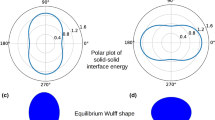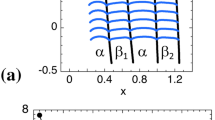Abstract
It is well documented in many experiments that crystallographic effects play an important role in the generation of two-phase patterns during the solidification of eutectic alloys. In particular, in lamellar composites, large patches of perfectly aligned lamellae are frequently observed. Moreover, the growth direction of the lamellae often markedly differs from the direction of the temperature gradient (the lamellae are tilted with respect to the main growth direction). Both of these effects cannot be explained either by the standard theory or the available numerical models of eutectic growth, which all assume the interfaces to be isotropic. We have developed a phase-field model in which the anisotropy of each interface (solid–liquid and solid–solid) can be separately controlled, and we have investigated the effect of interface anisotropy on the growth dynamics. We have found that anisotropy of the solid–solid interphase boundary free energy dramatically alters the growth dynamics. Tilted lamellae resulting from the modified equilibrium condition at the triple lines, is in good agreement with a theoretical conjecture proposed recently. In three dimensions, the interphase boundaries tend to align with directions of minimal energy. We have also performed simulations in which two grains with different anisotropies are in competition. In all cases, the grain containing the boundaries with the lowest energies was selected after a transient. These results shed new light on the selection of growth patterns in eutectic solidification.



Similar content being viewed by others
References
Jackson K A and Hunt J D, Trans Metall Soc AIME 236 (1966) 1129.
Hogan L M, Kraft R W, and Lemkey F D, Adv Mater Res 5 (1971) 83.
Caroli B, Caroli C, Faivre G, and Mergy J, J Cryst Growth 118 (1992) 135.
Choudhury A and Nestler B, Phys Rev E 85 (2012) 021602.
Ghosh S, Choudhury A, Plapp M, Bottin-Rousseau S, Faivre G, and Akamatsu S, Phys Rev E 91 (2015) 022407.
Akamatsu S, Bottin-Rousseau S, Şerefoğlu M, and Faivre G, Acta Mater 60 (2012) 3206.
Akamatsu S, Bottin-Rousseau S, Şerefoğlu M, and Faivre G, Acta Mater 60 (2012) 3199.
Hoffman D W and Cahn JW, Surf Sci 31 (1972) 368.
Hecht U, Witusiewicz VT, Drevermann A, and Rex S, Trans Ind Inst Met 58 (2005) 545.
Hecht U, Witisiewicz V, and Rex S, Mater Sci Forum 790–791 (2014) 343.
Lahiri A, and Choudhury A, Trans Ind Inst Met (this issue).
Acknowledgments
We thank Silvère Akamatsu, Sabine Bottin-Rousseau, and Gabriel Faivre for many stimulating discussions. This work was financially supported by Centre National d’Études Spatiales, France.
Author information
Authors and Affiliations
Corresponding author
Rights and permissions
About this article
Cite this article
Ghosh, S., Plapp, M. Influence of Interphase Anisotropy on Lamellar Eutectic Growth Patterns. Trans Indian Inst Met 68, 1235–1238 (2015). https://doi.org/10.1007/s12666-015-0711-9
Received:
Accepted:
Published:
Issue Date:
DOI: https://doi.org/10.1007/s12666-015-0711-9




